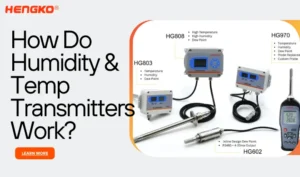
Wie funktionieren Feuchte- und Temperaturtransmitter?
In short, Humidity and temperature transmitters measure and send environmental data to control systems. They
Reliable OEM Partner for Dew Point Monitoring in Compressed Air, Gas, and Drying Systems
Startseite " Taupunkt-Messgerät
Designed for precision and durability, the HENGKO HG970 series offers a reliable dew point monitoring solution for demanding industrial environments. With high accuracy, fast response time, and robust stainless steel construction, the HG970 is ideal for continuous online measurement in compressed air systems, gas drying lines, and moisture-sensitive production processes. Whether you need analog or digital output, the HG970 series ensures stable performance and seamless integration into your control systems.
HG970 Series Dew Point Meter/ Temperature Humidity Selection Guide
| Modell | Temperaturbereich | Measurement Ranges (Humidity / Dew Point / Wet Bulb) | Accuracy (Temp / RH / Dew Point) | Sonde Typ | Anmeldung | Features / Notes |
| HG970 | -30 ~ 80℃ | Humidity Range: 0 ~ 100%RH / Dew Point Range: -30 ~ 80°C Td / Wet Bulb Range: 0 ~ 60°C WB | ±0.1℃ / ±1.5%RH / ±3°C Td | Auswechselbare Sonde | General-purpose monitoring in HVAC systems, laboratories, and industrial rooms | Standard model with easy-to-replace probe for regular maintenance |
| HG972 | -30 ~ 80℃ | Humidity Range: 0 ~ 100%RH / Dew Point Range: -30 ~ 80°C Td / Wet Bulb Range: 0 ~ 60°C WB | ±0.1℃ / ±1.5%RH / ±3°C Td | Runde Sonde | Compact systems like environmental test chambers, storage cabinets, or small control boxes | Space-saving round probe for tight installations |
| HG984 | -30 ~ 80℃ | Humidity Range: 0 ~ 100%RH / Dew Point Range: -30 ~ 80°C Td / Wet Bulb Range: 0 ~ 60°C WB | ±0.1℃ / ±1.5%RH / ±3°C Td | OEM Scharfe Sonde | OEM integration in compact equipment, sensor assemblies, or instrument panels | Custom sharp probe for embedded and OEM applications |
| HG983 | -30 ~ 100℃ | Humidity Range: 0 ~ 100%RH / Dew Point Range: -30 ~ 80°C Td / Wet Bulb Range: 0 ~ 60°C WB | ±0.1℃ / ±1.5%RH / ±3°C Td | Lange scharfe Sonde | Compressed air pipelines, drying ovens, and tank inlets | Extended reach probe ideal for insertion into ducts or deep ports |
| HG981 | -30 ~ 120℃ | Humidity Range: 0 ~ 100%RH / Dew Point Range: -30 ~ 80°C Td / Wet Bulb Range: 0 ~ 60°C WB | ±0.1℃ / ±1.5%RH / ±3°C Td | OEM lange Sonde | Lithium battery drying rooms, petrochemical high-temp gas lines | Long and durable probe for harsh, high-temperature applications |
| HG982 | -30 ~ 120℃ | Humidity Range: 0 ~ 100%RH / Dew Point Range: -30 ~ 80°C Td / Wet Bulb Range: 0 ~ 60°C WB | ±0.1℃ / ±1.5%RH / ±3°C Td | Split Sharp Probe | Industrial dryers, heated air chambers, or environments with difficult access | Split design for easier installation and probe positioning |
HG970 Series
Portable Dew Point Meter HG970 – Precision in Your Pocket
The Portable Dew Point Meter is a lightweight, field-ready device designed for fast,
accurate humidity and dew point measurements in a wide range of environments.
*Compact & Portable – Ideal for mobile use in field inspections and remote sites
*High Accuracy – Advanced sensors ensure precise dew point readings
*Versatile Applications – Suitable for HVAC checks, industrial spot measurements, and environmental monitoring
*Rapid Response – Quickly adapts to changing conditions for real-time results
*User-Friendly Interface – Simple controls and clear display for effortless operation
*Durable & Lightweight – Built to withstand demanding field conditions without added bulk
*Essential Tool – A must-have for professionals requiring reliable moisture data on the go
HENGKO ist ein weltweit führender Anbieter von industriellen Sensorlösungen, der für sein einzigartiges Design und seine hervorragende Leistung bekannt ist. Unsere Temperatur- und Feuchtigkeitstransmitter und -sensoren werden in einer Vielzahl von Branchen eingesetzt, darunter die Lebensmittel- und Getränkeindustrie, die pharmazeutische Industrie, die Fertigung und die Umweltüberwachung.
Sie können ein einzigartiges Taupunktsensorprodukt auf der Grundlage unserer patentierten und selbst entworfenen Taupunkttransmitter-Serie vollständig anpassen.
Sie erhalten einen viel niedrigeren und wettbewerbsfähigen Preis aufgrund unserer extrem kosteneffizienten Kontrolle.
Mit unseren ständig aktualisierten Produkten werden Sie den sich ständig ändernden Marktanforderungen gerecht.
Sie erhalten starke Marketing-Unterstützung, um Ihnen zu helfen, Produkte erfolgreich zu verkaufen, Material unterstützt gehören: hochauflösende Produktbilder, coole 3D-Effekt-Videos, und vieles mehr.










Taupunktsensor für die Überwachung von Druckluftsystemen : Optimale Kontrolle der Luftfeuchtigkeit und Luftqualität für Ihre Druckluftwerkstatt
HENGKO is a trusted manufacturer of high-performance dew point transmitters, temperature and humidity transmitters, and portable dew point meters.
We specialize in delivering a comprehensive range of monitoring solutions tailored to meet the precise needs of industrial and environmental applications.
Engineered for accuracy, durability, and long-term stability, our products ensure reliable performance across demanding conditions. Whether you’re looking for a precise dew point sensor or a rugged humidity transmitter, HENGKO offers both the technology and expertise to support your project.
👉 Contact us today to explore customized solutions that fit your monitoring challenges.






A Taupunkt-Messgerät is a precision instrument used to measure the dew point temperature—the temperature at which moisture in the air or gas begins to condense into liquid water. It is a key parameter for understanding humidity levels und moisture content in various industrial and environmental applications.
Maßnahmen dew point temperature in °C or °F
Indicates humidity saturation in air or gases
Helps detect moisture contamination in compressed air, gases, or controlled environments
Compressed air systems (prevent water accumulation)
Gas drying processes (e.g. nitrogen, argon, hydrogen)
HVAC-Systeme (ensure indoor climate control)
Lithium battery dry rooms (moisture-sensitive environments)
Pharmaceutical & food production (humidity-sensitive storage)
| Typ | Beschreibung |
|---|---|
| Portable Dew Point Meter | Handheld, used for spot-checks and field diagnostics |
| Online Dew Point Transmitter | Fixed installation, sends real-time data to control systems (e.g. 4–20 mA, RS485) |
| Mirror-type Hygrometer | Laboratory-grade, ultra-accurate but costly |
Prevents corrosion, condensation, and product defects
Ensures compliance with industry standards (ISO, GMP, etc.)
Enhances energy efficiency and equipment lifespan
Checking the dew point with the HG970 series portable dew point meter from HENGKO is a precise, efficient, and reliable process designed for both industrial field inspections and laboratory-quality measurements. The HG970 series offers various probe configurations to suit a wide range of applications, from general HVAC systems to high-temperature drying environments. Below is a step-by-step guide and technical overview of how the dew point measurement is conducted using this instrument.
The HG970 series includes multiple probe types (e.g., replaceable, sharp, long, split) and temperature ranges (-30°C to 120°C), allowing users to choose the most suitable model based on their measurement environment. For example:
HG970 / HG972: Ideal for general industrial and HVAC applications.
HG981 / HG982: Recommended for high-temperature environments (80–120°C), such as lithium battery drying rooms and gas pipelines.
Ensure the device is powered (via external power supply or field setup).
Connect the probe securely to the test point, pipe port, or environmental chamber.
For accurate results, avoid exposing the sensor to sudden humidity shocks or contaminants like oil or dust before the reading stabilizes.
Once connected, the HG970’s built-in sensing module continuously samples the air or gas, measuring parameters such as:
Dew Point Temperature (°C or °F)
Relative Humidity (%RH)
Ambient Temperature (°C/°F)
These values are calculated using HENGKO’s advanced polymer capacitive or ceramic sensor technology, offering fast response time und high accuracy even in dynamic or high-moisture environments.
If the model includes an LCD or digital interface (optional), the readings are displayed in real-time. For models without a display, the output is transmitted via:
Analog Signal (4–20 mA / 0–10 V)
Digital Communication (RS485 / Modbus-RTU)
These outputs can be logged via a data logger, PLC, or remote monitoring software.
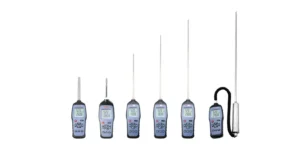
The dew point temperature tells you the exact point at which condensation would occur under current pressure and humidity conditions. Lower dew points indicate drier air, which is critical for:
Preventing corrosion or moisture damage in pneumatic tools or compressed air systems
Maintaining strict humidity control in cleanrooms, dry rooms, or gas drying processes
For example:
Dew point < -40°C: Suitable for high-purity gas systems and lithium battery environments.
Dew point 0 ~ 10°C: Typical in HVAC, food storage, and general industrial applications.
To maintain reliable performance:
Calibrate the device periodically (typically once every 6–12 months) against a traceable standard.
Clean or replace the sensor probe as needed, especially if used in harsh or dusty environments.
Store the unit in a dry and clean place when not in use.
✅ Wide temperature and humidity range
✅ Interchangeable probe options for different environments
✅ Compact and robust construction for field use
✅ High accuracy and fast response time
✅ Optional OEM customization for unique industrial requirements
Contact HENGKO’s technical team unter ka@hengko.com or visit www.hengkometer.com to get personalized advice based on your industry, installation method, and measurement conditions.
Die HG970 series dew point transmitters from HENGKO are designed for industrial-grade dew point monitoring with high precision and stability. The normal dew point measurement range of the HG970 series is typically:
-60°C to +60°C Td (typical)
(Custom ranges available upon request)
| Parameter | Details |
|---|---|
| Typical Range | -60°C ~ +60°C dew point (Td) |
| Luftfeuchtigkeitsbereich | 0%RH to 100%RH |
| Temperaturbereich | -30°C to +120°C (varies by model, e.g., HG970 to HG982) |
| Sensor-Typ | Polymer capacitive or ceramic sensor (high accuracy, fast response) |
| Ausgangssignal | 4–20mA, 0–5V, 0–10V, RS485 / Modbus-RTU |
| Genauigkeit | ±2°C Td typical (customizable based on sensor class) |
-60°C to -20°C Td: Ideal for compressed air drying systems, lithium battery dry rooms, or gas drying
-20°C to +20°C Td: Common in HVAC-Systeme, pharmaceutical environmentsund storage facilities
+20°C to +60°C Td: Suitable for high-moisture process areas, or climate chambers
If you need a customized dew point range, HENGKO can tailor the sensor configuration based on:
Target environment (dry gas, ambient air, high temp zone)
Accuracy requirement
Signal output preferences
📩 Contact: ka@hengko.com to request a custom specification or get technical support.
This is Great question!
Understanding the difference between Taupunkt und Feuchtigkeit is key to accurately evaluating air moisture content
—especially in industrial, HVAC, and environmental monitoring applications.
| Aspect | Taupunkt | Humidity (Relative Humidity, %RH) |
|---|---|---|
| Definition | Die Temperatur at which air becomes fully saturated and water vapor condenses into liquid | Die percentage of water vapor in the air compared to the maximum it can hold at a given temperature |
| Unit | °C or °F (Temperature) | %RH (Percentage) |
| Absolute/Relative? | Absolute measure of moisture content | Relative measure (depends on air temperature) |
| Temperature Dependent? | No – dew point is not affected by ambient temperature | Yes – higher temperatures can hold more moisture, affecting %RH |
| What it tells you | How dry or moist the air actually is | How close the air is to saturation at a given temperature |
| Used for | Precise control in drying, gas purity, industrial process monitoring | General comfort, climate control, environmental monitoring |
| Example | Dew point of -40°C = extremely dry air (used in lithium battery rooms) | 60%RH at 25°C = moderately humid air |
Taupunkt = “How much water is really in the air?”
Relative Humidity = “How full is the air’s moisture tank at this temperature?”
| Ambient Temp | Taupunkt | Relative Humidity |
|---|---|---|
| 25°C | 10°C | ~45%RH |
| 25°C | 20°C | ~75%RH |
| 25°C | 24°C | ~95%RH |
Verwenden Sie Taupunkt for:
Compressed air drying systems
Inert gas monitoring (N₂, Ar, H₂)
Lithium battery dry rooms
Verwenden Sie %RH for:
Indoor air quality
HVAC system control
Agricultural storage
Even though the temperature is the same, the dew point increases with more water vapor in the air, which raises the relative humidity.
Both devices are used to measure the dew point temperature, a critical parameter in determining moisture levels in air or gas. However, they differ significantly in design, applicationund integration method.
| Aspect | Beschreibung |
|---|---|
| Measurement Function | Both measure dew point temperature accurately to detect moisture levels |
| Sensor Technology | Typically use similar capacitive or ceramic humidity sensors |
| Target Media | Both used with air, compressed gases, dry gases, etc. |
| Anwendungen | Found in industrial, HVAC, environmental monitoringund gas drying |
| Feature / Aspect | Taupunkt-Messgerät | Taupunkt-Transmitter |
|---|---|---|
| Form Factor | Portable or handheld | Fixed-installation / inline sensor |
| Display | Built-in LCD or digital display | Usually no display (or optional), outputs data to external systems |
| Power Source | Battery-powered or rechargeable | Externally powered (e.g., 24V DC) |
| Ausgangssignal | Internal data logging, USB export (optional) | Analog (4-20 mA, 0-10V) or Digital (RS485/Modbus-RTU) |
| Use Case | On-site spot checks, mobile inspections | Continuous online monitoring & automation systems |
| User Type | Technicians, maintenance staff | Engineers, system integrators, automation specialists |
| Einrichtung | Handheld use or temporary probe connection | Installed permanently in pipelines, dryers, tanks, etc. |
| Preisspanne | Generally higher due to display and portability features | More cost-effective for long-term embedded use |
| Typical Examples | Vaisala DM70, Michell MDM300, HG970 series | HENGKO HG970, Vaisala DMT143, E+E EE371 |
| Scenario | Recommended Device |
|---|---|
| Field diagnostics and mobile inspections | Taupunkt-Messgerät |
| Continuous monitoring in a compressed air line | Taupunkt-Transmitter |
| Temporary measurements in different locations | Taupunkt-Messgerät |
| Integration into control/SCADA systems | Taupunkt-Transmitter |
Dew Point Meters are portable tools designed for manual measurements, great for spot-checking and troubleshooting.
Dew Point Transmitters are installed devices built for long-term, real-time monitoring und system automation.
Der 4-20mA-Ausgang ist eine beliebte Wahl für Taupunktsensoren, da es sich um einen industriellen Standardausgang handelt, der mit einer Vielzahl von Steuersystemen kompatibel ist. Es handelt sich außerdem um einen sehr zuverlässigen und geräuscharmen Ausgang, der sich gut für den Einsatz in rauen Industrieumgebungen eignet.
Hier sind einige der Vorteile der Verwendung eines 4-20mA-Ausgangs für Taupunktsensoren:
Kompatibilität: Der 4-20mA-Ausgang ist mit einer Vielzahl von Steuerungssystemen kompatibel, darunter SPS, DCS und SCADA-Systeme. Dies macht es einfach, Taupunktsensoren in bestehende Steuersysteme zu integrieren.
Verlässlichkeit: Der 4-20mA-Ausgang ist ein sehr zuverlässiger Ausgang, der nicht anfällig für Rauschstörungen ist. Dies ist wichtig für Taupunktsensoren, die häufig in rauen Industrieumgebungen eingesetzt werden.
Genauigkeit: Der 4-20mA-Ausgang kann genaue Messungen des Taupunkts liefern. Dies ist wichtig für Anwendungen, bei denen eine präzise Taupunktsteuerung erforderlich ist.
Reichweite: Der 4-20mA-Ausgang kann einen breiten Bereich von Taupunktwerten abdecken. Dies macht ihn für eine Vielzahl von Anwendungen geeignet.
Kosten: Der 4-20mA-Ausgang ist ein relativ kostengünstig zu implementierender Ausgang. Dies macht ihn zu einer kostengünstigen Option für Taupunktsensoren.
Neben den oben genannten Vorteilen ist der 4-20mA-Ausgang auch ein sehr vielseitiger Ausgang. Er kann zur Übertragung einer Vielzahl anderer Parameter wie Temperatur, Druck und Durchflussmenge verwendet werden. Dies macht ihn zu einem wertvollen Ausgang für eine breite Palette von industriellen Anwendungen.
Hier sind einige Beispiele für Anwendungen, bei denen Taupunktsensoren mit 4-20mA-Ausgängen üblicherweise eingesetzt werden:
Druckluftsysteme: Taupunktsensoren werden in Druckluftsystemen eingesetzt, um den Feuchtigkeitsgehalt der Luft zu überwachen und zu steuern. Dies ist wichtig, um Korrosion und andere Schäden an der Ausrüstung zu verhindern.
HLK-Systeme: Taupunktsensoren werden in HLK-Systemen zur Kontrolle der Luftfeuchtigkeit in Gebäuden eingesetzt. Dies ist wichtig für den menschlichen Komfort und die Gesundheit.
Industrielle Trocknungsprozesse: Taupunktsensoren werden in industriellen Trocknungsprozessen zur Überwachung und Kontrolle des Feuchtigkeitsgehalts des zu trocknenden Produkts eingesetzt. Dies ist wichtig, um die Qualität des Produkts zu gewährleisten.
Verarbeitung von Lebensmitteln und Getränken: Taupunktsensoren werden in der Lebensmittel- und Getränkeindustrie eingesetzt, um den Feuchtigkeitsgehalt des zu verarbeitenden Produkts zu kontrollieren. Dies ist wichtig, um die Sicherheit und Qualität des Produkts zu gewährleisten.
Überwachung der Umwelt: Taupunktsensoren werden in Umweltüberwachungsstationen eingesetzt, um Änderungen des Feuchtigkeitsgehalts in der Atmosphäre zu verfolgen. Diese Informationen können zur Vorhersage von Wetterbedingungen und zur Erkennung potenzieller Umweltprobleme verwendet werden.
Wie Sie sehen, sind Taupunktsensoren mit 4-20mA-Ausgängen ein wertvolles Werkzeug für eine Vielzahl von industriellen Anwendungen. Sie sind zuverlässig, genau und vielseitig und können leicht in bestehende Kontrollsysteme integriert werden.
Der Preis von Taupunkt-Transmittern kann je nach Hersteller, Ausstattung und Genauigkeit des Transmitters variieren. Im Allgemeinen kosten Taupunkttransmitter mit höherer Genauigkeit und mehr Funktionen mehr als Taupunkttransmitter mit geringerer Genauigkeit und weniger Funktionen.
Nach meinen Recherchen würde ich sagen, dass der Preis von Taupunkt-Transmittern im Allgemeinen angemessen ist. Die Kosten für die Komponenten und die Arbeit, die zur Herstellung von Taupunkttransmittern erforderlich sind, sind hoch, und die Unternehmen, die Taupunkttransmitter herstellen, müssen diese Kosten wieder hereinholen, um im Geschäft zu bleiben. Darüber hinaus werden Taupunkttransmitter in einer Vielzahl von kritischen Anwendungen eingesetzt, weshalb es wichtig ist, dass sie zuverlässig und genau sind. Der hohe Preis von Taupunkttransmittern spiegelt die Tatsache wider, dass es sich um qualitativ hochwertige Instrumente handelt, auf deren genaue Messungen man sich verlassen kann.
Hier sind einige Faktoren, die den Preis eines Taupunkt-Transmitters beeinflussen können:
Hier finden Sie eine Tabelle mit der Preisspanne der auf dem Markt befindlichen Taupunkt-Transmitter:
| Typ | Preisspanne |
|---|---|
| Gekühlter Spiegel | $2,000 – $10,000 |
| Polymer | $500 – $2,000 |
| Metalloxid | $500 – $1,500 |
Wie Sie sehen, kann die Preisspanne für Taupunkttransmitter je nach Transmittertyp variieren. Kühlspiegel-Taupunkttransmitter sind die teuerste Art von Transmitter, aber auch die genaueste. Polymer- und Metalloxid-Taupunkttransmitter sind weniger teuer, aber auch weniger genau.
Der Preis von Taupunkt-Transmittern kann auch je nach den Funktionen des Transmitters variieren. Zum Beispiel kosten Taupunkt-Transmitter mit Datenprotokollierung, Alarmsollwerten und Fernzugriffsfunktionen in der Regel mehr als Taupunkt-Transmitter mit weniger Funktionen.
Wenn Sie auf der Suche nach einem hochwertigen Taupunktmessgerät sind, würde ich Ihnen empfehlen, eines von einer bekannten Marke zu kaufen, die einen guten Ruf für Qualität und Zuverlässigkeit hat. Sie sollten auch die Funktionen berücksichtigen, die für Sie wichtig sind, und die Genauigkeit, die Sie benötigen. Wenn Sie sich nicht sicher sind, welcher Taupunkt-Transmitter der richtige für Sie ist, empfehle ich Ihnen, sich von einem Fachmann beraten zu lassen, der Ihnen helfen kann, eine fundierte Entscheidung zu treffen.
some questions about Dew Point Meter you like to know
A Taupunkt-Messgerät is a precision instrument used to measure the dew point temperature — the temperature at which air or gas becomes saturated with moisture and water vapor begins to condense into liquid.
It works by sensing the relative humidity and temperature of the environment or gas stream, then calculating the dew point based on the current saturation level. Most modern dew point meters use capacitive or ceramic sensors for real-time measurements, offering high accuracy and stability across a wide range of industrial applications.
Dew point measurement is critical for moisture control, especially in applications where excess humidity can lead to equipment failure, corrosion, product spoilage, or safety risks.
Industries such as compressed air systems, pharmaceuticals, lithium battery manufacturing, semiconductorsund food packaging depend on dew point monitoring to ensure dry environments and gas purity. In compressed air lines, for example, a low dew point prevents water buildup, which could otherwise damage tools and contaminate end products.
Taupunkt is the absolute temperature at which air becomes saturated and water vapor condenses, while humidity (usually relative humidity) is a percentage expressing how much moisture the air currently holds compared to its maximum capacity at a given temperature.
In simple terms:
Taupunkt tells you how much moisture is actually in the air (in °C or °F).
Relative humidity tells you how close the air is to saturation (in %RH).
Dew point is more accurate for industrial applications, especially when monitoring drying processes or compressed air systems.
In industrial compressed air systems, the target dew point depends on the drying method und application sensitivity:
| Anmeldung | Recommended Dew Point |
|---|---|
| General industrial use | -20°C to -40°C |
| Instrumentation or electronics | -40°C to -70°C |
| Medical/Pharma cleanrooms | ≤ -40°C |
| Standard shop air (non-critical) | 0°C to -10°C |
A lower dew point means drier air, which is essential for high-performance or sensitive operations. The dew point meter helps monitor this and ensure system compliance.
Yes. Most dew point meters — including advanced portable models — can be used to measure dew point in a variety of non-corrosive gases, such as nitrogen (N₂), argon (Ar), carbon dioxide (CO₂)und compressed natural gas (CNG).
However, it is important to verify:
Sensor compatibility with the target gas
Pressure rating of the probe or housing
Flow regulation to avoid sensor contamination
Some models, like the HENGKO HG970 series, offer custom probe materials and protective filters for specialized gas monitoring applications.
For most industrial and professional uses, dew point meters should be calibrated every 6 to 12 months, depending on usage frequency, environmental conditions, and accuracy requirements.
Regular calibration:
Ensures data reliability
Maintains regulatory compliance (e.g., ISO, GMP)
Extends the lifespan of the sensor
HENGKO and other manufacturers often offer traceable calibration services and replacement sensors for field units.
Typical high-quality portable dew point meters can measure within a range of:
-80°C to +60°C (or -112°F to +140°F)
For example, the HG970 series by HENGKO is commonly used to monitor dew point ranges from -60°C to +60°C, making it suitable for most industrial air and gas drying applications. Some lab-grade mirror hygrometers may extend lower, but portable models balance range with portability and cost-effectiveness.
Using a portable dew point meter is straightforward:
Power on the device (battery or external power).
Connect the probe to the sample point or open environment.
Allow stabilization time (usually 30 seconds to a few minutes).
Observe the real-time dew point reading on the display or via signal output.
Log or export data if required (some models offer USB or Bluetooth).
Always make sure the sensor is clean, calibrated, and not exposed to oil, dust, or corrosive chemicals.
A Taupunkt-Messgerät is portable and often used for spot-checking or mobile diagnostics.
A Taupunkt-Transmitter is a fixed, inline sensor installed for continuous monitoring in automated systems.
Dew point meters typically include a display and internal battery, while transmitters are integrated with PLCs or data loggers via analog (4-20mA) or digital (RS485/Modbus) output.
Yes — if it’s rated for industrial or field use. Look for:
IP-rated housing for dust and moisture protection
Stainless steel probe construction
Temperature range compatibility (e.g., -30°C to +120°C)
Shock-resistant casing
Models like the HENGKO HG970 series are designed for demanding conditions, including outdoor gas lines, drying towers, or factory production lines.
Kontaktieren Sie HENGKO noch heute bei Fragen zu Temperatur- und Feuchtesensoren, Messumformern und Lösungen

In short, Humidity and temperature transmitters measure and send environmental data to control systems. They
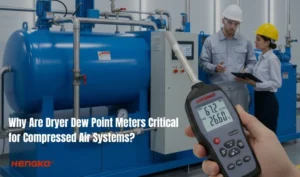
Why Are Dryer Dew Point Meters Critical for Compressed Air Systems? Maybe You always battle

Why One Office Zone is Too Humid & How a Humidity Transmitter Fixes It Persistent
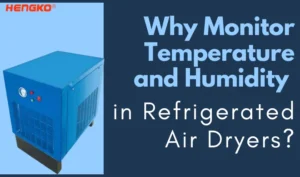
Einleitung Druckluft wird in der modernen Industrie oft als "vierte Energiequelle" bezeichnet, neben

1. Einleitung Die Halbleiterindustrie arbeitet unter einigen der strengsten Umweltbedingungen der
Wenden Sie sich an unser Expertenteam, wenn Sie persönliche Unterstützung benötigen, und wir werden Ihnen umgehend die besten Lösungen für Temperatur- und Feuchtetransmitter und -sensoren anbieten, die auf Ihre spezifischen Anforderungen zugeschnitten sind.
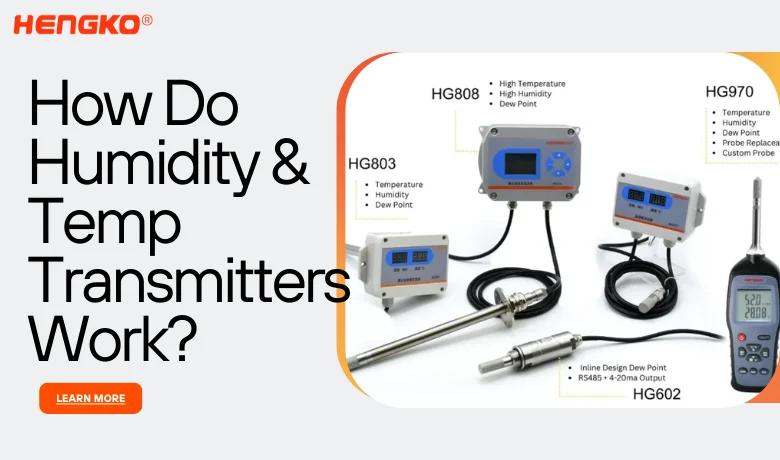
Kurz gesagt, Feuchte- und Temperaturtransmitter messen und senden Umgebungsdaten an Kontrollsysteme. Sie werden häufig in den Bereichen HLK, Pharmazeutika, Lebensmittelverarbeitung und Reinräume eingesetzt.

In short, Humidity and temperature transmitters measure and send environmental
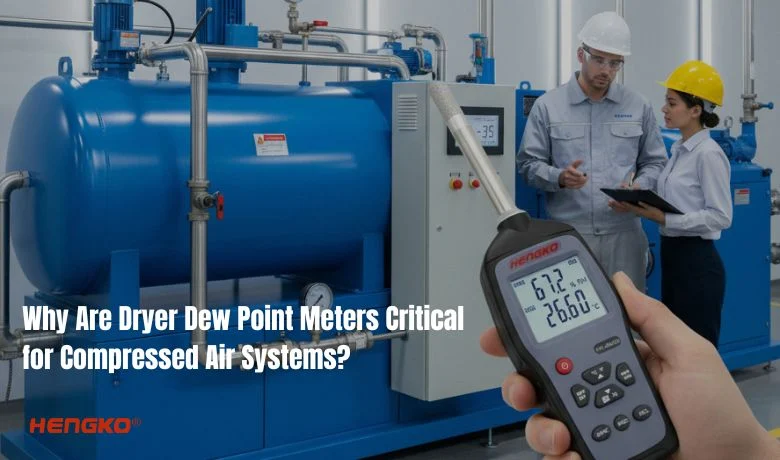
Why Are Dryer Dew Point Meters Critical for Compressed Air

Why One Office Zone is Too Humid & How a
WhatsApp uns